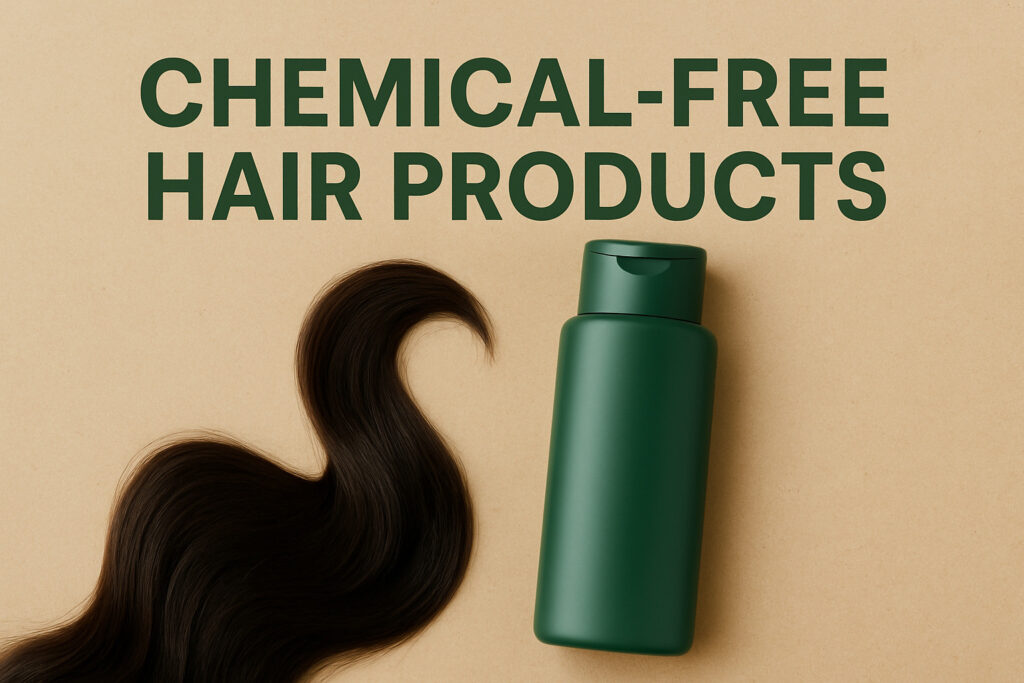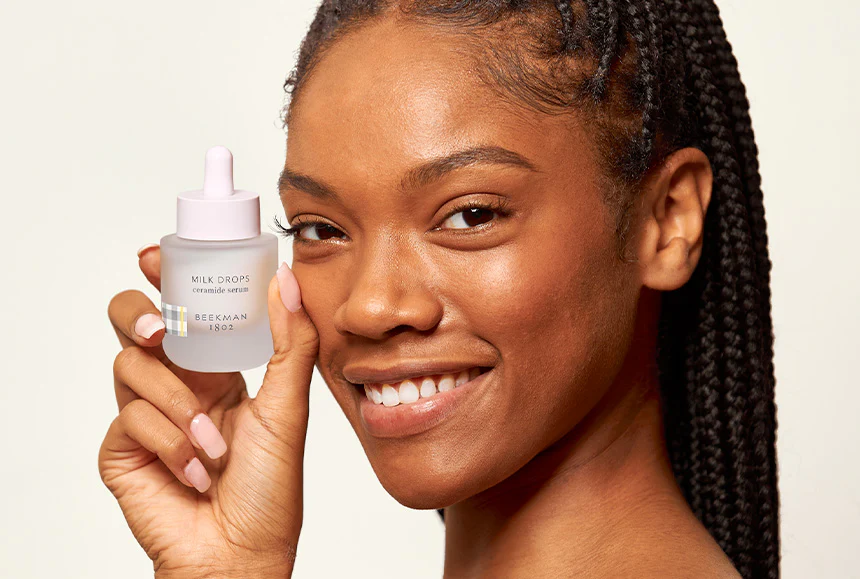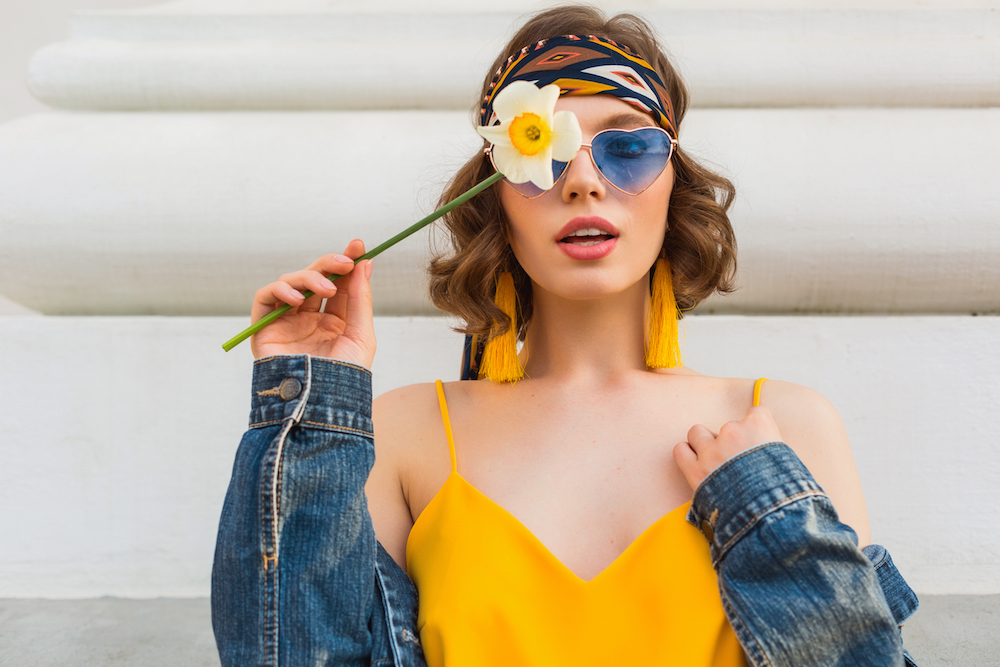Why Clean Hair Care Matters More Than Ever
Chemical-free hair products are formulated without harsh synthetic ingredients like sulfates, parabens, phthalates, and formaldehyde-releasing preservatives. Here’s what you need to know:
Top Chemical-Free Hair Product Categories:
• Sulfate-free shampoos – gentle cleansing without stripping natural oils
• Plant-based conditioners – hydration from botanical oils and butters
• Natural styling products – hold and texture from plant extracts
• Botanical scalp treatments – nourishing serums with essential oils
Key Ingredients to Avoid:
• Sodium lauryl sulfate (SLS) and sodium laureth sulfate (SLES)
• Parabens (methylparaben, propylparaben)
• Phthalates (often hidden in “fragrance”)
• Formaldehyde and formaldehyde-releasing preservatives
The clean beauty movement isn’t just a trend – it’s a response to real health concerns. Research shows that more than 1,000 ingredients banned in Europe are still allowed in American personal care products. Even more alarming, studies found that 84% of chemicals detected in hair products marketed to Black women weren’t even listed on the label.
Your scalp absorbs what you put on it. And with the average shampoo containing 10 to 30 different ingredients, many of which are linked to skin irritation and hormone disruption, it’s no wonder people are seeking safer alternatives.
The good news? Chemical-free doesn’t mean compromise. Modern botanical formulations deliver the performance you want without the toxins you don’t need. From volumizing mousses made with quinoa protein to clarifying shampoos powered by tea tree oil, there’s a clean solution for every hair type and concern.

Relevant articles related to chemical-free hair products:
– anti-pollution skincare routine
– beauty tips for clear and glowing skin
What Does “Chemical-Free” Hair Really Mean?
Here’s the truth that might surprise you: everything is technically a chemical, including the water you drink and the air you breathe. When we talk about chemical-free hair products, we’re really referring to formulations that skip the synthetic nasties known to cause harm to your health and the planet.
Think of it this way – these products accept ingredients that come straight from nature’s pharmacy. We’re talking plant oils, botanical extracts, and mineral-based preservatives instead of lab-created compounds linked to skin irritation, hormone chaos, and environmental damage.
But here’s where things get tricky. The beauty industry in the United States operates with surprisingly little oversight. Unlike food labels, terms like “chemical-free,” “non-toxic,” and “clean” have zero regulatory meaning. Companies can slap these feel-good claims on their bottles without anyone checking their homework.
This regulatory gap creates the perfect playground for greenwashing – where brands dress up their products in green marketing while still loading them with questionable ingredients. It’s like putting a healthy-looking salad on the menu but serving it with a side of deep-fried everything.
One of the sneakiest tricks? The “fragrance” loophole. Companies aren’t required to tell you what’s actually in their signature scents because they’re considered trade secrets. This means hormone-disrupting phthalates and other concerning chemicals can hide behind that innocent word “fragrance” on your ingredient list.
The good news is you don’t have to steer this maze alone. Learning to decode ingredient lists is like having a superpower in the beauty aisle. Our guide Beyond the Label: How to Read Clean Beauty Ingredients Like a Pro breaks down exactly what to look for and what to avoid.
Hidden Toxins Lurking in Conventional Hair Care
Ready for some eye-opening facts? The research on what’s hiding in conventional hair care products is pretty shocking. Let’s shine a light on the worst offenders you’ll want to avoid.
Formaldehyde tops our list of hair care villains. The EPA has classified this preservative as a probable human carcinogen, yet it still shows up in many hair treatments and straightening products. The scientific research on formaldehyde hazards makes for some seriously concerning reading.
Parabens are another group of troublemakers. These preservatives act like fake estrogen in your body, potentially throwing your hormones out of whack. Even more alarming? Studies have detected parabens in breast cancer tissue, though researchers are still working to understand the connection.
Here’s something that really gets our attention: phthalates love to play hide-and-seek in “fragrance” blends. The CDC has linked these chemicals to reproductive issues in animal studies. What’s particularly troubling is that Black Americans show phthalate levels that are 1.8 times higher than white Americans – highlighting serious equity issues in beauty product safety.
Sulfates like SLS and SLES might create that satisfying lather, but they’re basically doing a strip-and-destroy mission on your hair. Beyond stealing your hair’s natural moisture and fading your color, these harsh detergents can also mess with your hormones. If you have curly or textured hair, sulfates are especially damaging.
Retinyl palmitate sounds fancy, but this vitamin A derivative can actually make your skin more sensitive to sun damage. Not exactly what you want from a hair product that might drip onto your face and neck.
Don’t overlook methylisothiazolinone either. This tongue-twisting preservative is a known allergen that can leave your scalp red, itchy, and irritated.
The cumulative effect of these chemicals is what really concerns researchers. Women of color face disproportionately higher exposure levels, with studies showing that hairdressers serving women of color have liftd phthalate levels compared to the general population. It’s a reminder that clean beauty isn’t just about personal choice – it’s about health equity too.
Ingredients to Skip & Plant-Powered Swaps
The beauty of switching to chemical-free hair products lies in finding that nature often does it better. While conventional hair care relies on harsh synthetics to create immediate (but temporary) results, plant-based alternatives actually improve your hair’s health over time.
Let’s start with the big offenders you’ll want to avoid. Sulfates like SLS and SLES strip your hair’s natural oils and can fade color faster than you can say “expensive salon treatment.” The plant-powered swap? Coconut-derived surfactants that cleanse gently without leaving your hair feeling like straw.
Synthetic fragrance is another major red flag – it’s often hiding phthalates and other hormone disruptors. Instead, look for products scented with essential oils or go completely fragrance-free if you have sensitive skin. Your scalp (and endocrine system) will thank you.
Here’s where it gets interesting: silicones might make your hair feel smooth temporarily, but they’re basically plastic coating that prevents moisture from getting in. Jojoba oil and argan oil actually penetrate the hair shaft to nourish from within. It’s the difference between putting a Band-Aid on a problem and actually healing it.
Parabens are still lurking in many hair products as preservatives, despite research linking them to hormone disruption. Smart brands now use vitamin E and rosemary extract for natural preservation that won’t mess with your body’s delicate systems.
One of the most exciting developments in clean hair care is the use of rice water protein. This ancient beauty secret contains amino acids that can actually strengthen hair from the inside out – something synthetic proteins simply can’t match. Quinoa protein is another plant-based powerhouse that repairs damage while adding shine.
And let’s talk about moisture. Instead of petroleum-based ingredients that sit on top of your hair, shea butter and coconut oil provide deep hydration without the heavy build-up. They work with your hair’s natural structure instead of against it.
The key thing to remember is that botanical ingredients work differently than their synthetic counterparts. They may take a few weeks to show their full benefits, but they’re actually improving your hair’s health rather than just masking problems with temporary fixes.
For more guidance on making smart ingredient swaps, our comprehensive guide to Clean Beauty Products breaks down everything you need to know about choosing truly effective natural alternatives.
Best Chemical-Free Hair Products for Every Hair Type
Finding chemical-free hair products that actually work can feel like searching for a unicorn. But here’s the thing – we’ve done the heavy lifting for you. After testing countless formulations, we’ve finded that the best clean hair products don’t just avoid toxic ingredients, they actually outperform their conventional counterparts.
The secret lies in understanding that plant-based ingredients work differently than synthetic ones. They may take a few weeks to show their full potential, but they’re actually healing your hair from the inside out rather than just masking problems with temporary fixes.
Chemical-Free Hair Products: Shampoos & Cleansers
Your cleansing routine sets the stage for everything else, so getting this step right is crucial. The best sulfate-free shampoos create a rich, satisfying lather without stripping away your scalp’s natural protective oils.
If you have oily hair, tea tree and charcoal-based formulas are your best friends. These ingredients naturally regulate oil production without triggering your scalp to overproduce sebum. Try the double-cleanse method – shampoo twice with a small amount each time for thorough cleansing without harshness.
For dry or damaged hair, look for coconut oil and shea butter-based cleansers that moisturize while they clean. Evening primrose and argan oil add an extra layer of nourishment that your hair will drink up.
Color-treated hair needs extra gentle care, and rose or fig-based shampoos are perfect for protecting your investment. Sulfates can strip color in just a few washes, so avoiding them isn’t just about health – it’s about keeping your color vibrant longer.
Sensitive scalps respond beautifully to fragrance-free formulas with chamomile or aloe vera. Here’s a fascinating fact: clinical studies show that 70% of people with body acne and 52% with facial acne saw improvement after switching to fragrance-free, non-toxic shampoo. Your scalp will thank you too.
Don’t overlook shampoo bars – these concentrated powerhouses eliminate plastic packaging while lasting 2-3 times longer than liquid formulas. They’re perfect for travel and surprisingly luxurious once you get used to them.
Nourishing Chemical-Free Conditioners & Masks
This is where plant-based formulas really get to show off. Natural oils and butters don’t just sit on your hair’s surface – they actually penetrate the hair shaft to repair damage from within.
Deep moisturizing conditioners with avocado, coconut, and argan oils work like a green smoothie for your hair. These ingredients rebuild your hair’s structure rather than just coating it with temporary smoothness that washes away.
When your hair needs protein repair, rice water and quinoa proteins are gentler alternatives to synthetic options. They won’t cause the brittleness that can come from protein overload, and they’re packed with amino acids that your hair actually recognizes and can use.
Leave-in treatments with green tea and calendula are especially wonderful for curly and textured hair that needs ongoing moisture between washes. They provide protection without that heavy, weighed-down feeling.
For weekly pampering, honey and hibiscus masks offer intensive repair that feels like a spa day at home. The natural enzymes in honey smooth your hair cuticle while hibiscus adds incredible shine and strength.
Styling Without the Chemicals

Gone are the days when choosing natural meant sacrificing style. Modern natural styling products deliver salon-worthy results without the toxic chemical cocktail found in conventional formulas.
Natural mousses made with quinoa and acacia gum create amazing lift and texture, especially on fine hair that needs body without weight. Unlike synthetic polymers that leave your hair feeling crunchy, these formulas move naturally with your hair.
Plant-based gels using meadowsweet and aloe vera provide flexible hold that actually gets better throughout the day. They won’t flake or create that stiff helmet feeling that makes you want to avoid touching your hair.
Texturizing sprays with sea salt and lavender are perfect for creating those effortless, beachy waves we all love. They add just enough grip and texture to make your hair look like you spent the day at the ocean.
Scalp-safe serums with spearmint and meadowsweet do double duty – they stimulate circulation for healthier hair growth while providing light styling benefits. They’re especially great if you’re dealing with thinning hair or scalp sensitivity.
The secret to styling with natural products is layering. Start with a leave-in treatment on damp hair, add your styling product, and finish with a light mist for hold. This technique builds beautiful texture and longevity without any heaviness.
Targeted Treatments & Scalp Care
Your scalp is the soil where beautiful hair grows, and botanical treatments excel at creating the perfect environment without irritation or harsh side effects.
Growth-stimulating treatments with rosemary and peppermint oils aren’t just old wives’ tales – they’re backed by real science. Rosemary contains ursolic acid, which boosts oxygen and nutrients to your hair follicles, while peppermint increases circulation.
Dandruff control gets a gentle makeover with tea tree oil and zinc-based treatments. These natural alternatives manage flakes just as effectively as conventional anti-dandruff products, and tulsi extract has been shown to work as well as over-the-counter options.
Post-color care is where honey and hibiscus treatments really shine. They repair processing damage while maintaining your color’s vibrancy, strengthening your hair without interfering with those expensive color molecules.
Scalp exfoliation with sugar cane and tea tree scrubs removes build-up and dead skin cells, creating a clean slate for healthy hair growth. Use these weekly treatments as part of your self-care routine.
The double-cleanse method works beautifully with scalp treatments too. Massage in your treatment and let it work for 5-10 minutes, then follow with a gentle shampoo to remove residue while keeping all those beneficial ingredients working for you.
Certifications & Smart Shopping Tips

Shopping for truly clean hair care can feel overwhelming when every brand claims to be “natural” or “non-toxic.” The secret? Look past the marketing fluff and focus on legitimate certifications that actually mean something.
EWG Verified is the gold standard you want to see. This certification means products have been rigorously tested and meet strict health standards – no harmful chemicals, complete ingredient transparency, and manufacturing safety protocols. When you see this seal, you know the product has passed one of the most thorough vetting processes available.
Certified B Corporation status tells you the entire company operates ethically. These businesses meet high standards for social and environmental responsibility, which often translates to better products and more honest marketing practices.
For plant-based formulations, Non-GMO Project Verified ensures the botanical ingredients haven’t been genetically modified. This matters because many conventional crops used in beauty products are heavily modified and treated with pesticides.
Leaping Bunny Certified remains the most trusted cruelty-free certification. Unlike other labels that can be misleading, this one requires companies to open their supply chains for independent auditing.
Here’s a money-saving tip: many effective chemical-free hair products cost less than you’d expect. The key is knowing where to look and what to prioritize. Some brands offer EWG-verified shampoos made with 98% naturally sourced ingredients at surprisingly accessible prices.
Use ingredient databases like EWG’s Skin Deep to research products before you buy. This free tool rates products and ingredients based on safety data, helping you avoid endocrine disruptors and other harmful chemicals that can accumulate in your body over time.
The investment in clean products makes even more sense when you consider the research. Studies continue to reveal how synthetic chemicals in conventional beauty products can disrupt hormones and cause long-term health issues. Your hair care routine shouldn’t come with health risks.
For more guidance on making smart choices that protect both your health and your wallet, check out our comprehensive Clean Beauty Tips guide.
Transitioning to a Chemical-Free Routine & Eco Packaging

Making the switch to chemical-free hair products feels exciting, but let’s be real – your hair might throw a little tantrum at first. After years of synthetic products, your scalp needs time to remember how to behave naturally.
The first two weeks can feel like a hair detox. Don’t panic if your locks feel greasier or different than usual. Your scalp has been overproducing oil to compensate for harsh sulfates stripping everything away. Think of it as your hair learning to trust you again.
By week three or four, you’ll start finding your groove. This is when technique becomes your best friend. Natural products love damp hair, so apply your conditioner or styling products when your hair is still wet from the shower. A wide-tooth comb helps distribute everything evenly without creating frizz.
The magic really happens around month two or three. This is when friends start asking what you’re doing differently. Your hair feels stronger, looks shinier, and actually behaves better. The patience pays off in spades.
Patch testing isn’t just a suggestion – it’s your insurance policy. Even natural ingredients can cause reactions, especially if you have sensitive skin. Test new products behind your ear and wait 24-48 hours before diving in headfirst.
If you have a sensitive scalp, start your journey with fragrance-free formulas. Essential oils are wonderful, but they can be too intense initially. Clinical studies show that people with scalp conditions see real improvement when they ditch toxic formulations, but gentle wins the race here.
The packaging revolution happening in clean beauty is honestly impressive. Shampoo bars have completely eliminated the need for plastic bottles while lasting twice as long as liquid versions. Aluminum containers can be recycled forever without losing quality, and glass bottles turn your bathroom into a chic, spa-like space.
Many brands now offer refill programs that cut packaging waste by up to 80%. You keep your beautiful glass bottle and just refill it when needed. Some companies have even gone plastic-negative, meaning they’re actually removing more plastic from the environment than they use.
The environmental benefits go way beyond pretty packaging. When you rinse chemical-free hair products down the drain, you’re not sending toxins into waterways. Biodegradable formulations break down naturally instead of accumulating in rivers and oceans, protecting the fish and ecosystems we all depend on.
Ready to create your own sustainable beauty sanctuary? Our guide to Eco-Friendly Beauty Routines has everything you need to make your entire routine planet-friendly.
Frequently Asked Questions about Chemical-Free Hair Products
Do chemical-free formulas work on curly or color-treated hair?
Here’s the wonderful truth: chemical-free hair products are actually better for textured and processed hair than their conventional counterparts. If you have curls, you probably already know the frustration of products that leave your hair frizzy, dry, or completely lacking definition. That’s because harsh sulfates disrupt your hair’s natural curl pattern and strip away the moisture that curly hair desperately needs.
Color-treated hair faces similar challenges. Those beautiful highlights or that perfect balayage can fade dramatically when exposed to aggressive cleansing agents. Synthetic sulfates are notorious for stripping color molecules right out of your hair shaft, sometimes in just a few washes.
Plant-based formulations work differently. They cleanse gently while actually nourishing your hair. Coconut oil and shea butter provide the deep moisture that curly and chemically-treated hair craves, while gentle surfactants clean without causing damage.
The secret is matching the right natural ingredients to your specific needs. Dry, damaged hair thrives with rich botanical oils, while fine hair does better with lighter plant extracts that won’t weigh it down.
How do prices compare with mainstream products?
Let’s talk numbers, because this is where chemical-free hair products often surprise people. While some premium botanical formulations do cost more upfront, the math actually works in your favor when you look at the bigger picture.
Concentrated natural formulas mean you use less product each time. A single shampoo bar can outlast two or three bottles of liquid shampoo. That $12 bar that seemed expensive? It might actually cost you less per wash than your regular drugstore shampoo.
Quality chemical-free options range from about $0.81 to $4.75 per ounce, which puts them right in line with conventional premium products. The difference is that you’re investing in ingredients that actually improve your hair’s health over time, rather than just masking problems temporarily.
Budget-conscious shoppers have plenty of options too. Many brands offer EWG-verified formulations at accessible price points, proving that clean beauty doesn’t have to break the bank. Plus, when your hair gets healthier, you often need fewer styling products and treatments, which saves money in the long run.
Will my scalp purge when I switch to non-toxic hair care?
The good news is that switching to chemical-free hair products typically doesn’t cause the dramatic “purging” you might experience with skincare transitions. What you’re more likely to notice is a gentle adjustment period as your scalp learns to function without synthetic crutches.
Your scalp has been working overtime to compensate for harsh chemicals. Sulfates strip natural oils, so your scalp produces extra sebum to protect itself. Synthetic ingredients can also create buildup that affects how your hair looks and feels.
During the first week or two, you might notice your hair feels slightly different. Maybe it’s a bit greasier as your oil production normalizes, or perhaps it feels drier as buildup washes away. This is your scalp rebalancing itself naturally.
Most people find this transition surprisingly smooth, especially when they introduce new products gradually rather than switching everything at once. By week three or four, you’ll likely notice improvements in both scalp comfort and hair texture.
The key is being patient with the process. Your hair has been conditioned to expect synthetic ingredients, so it needs time to appreciate the gentler approach of botanical formulations. Trust the process – your scalp will thank you for the break from harsh chemicals.
Conclusion
Your journey toward chemical-free hair products is really about choosing formulations that work with your hair’s natural biology instead of against it. The evidence keeps mounting that botanical ingredients like rosemary, tea tree, and plant-based proteins don’t just avoid harm – they actually deliver better long-term results than synthetic alternatives.
Think about it: your scalp is living, breathing skin that deserves the same gentle care you’d give your face. When you nourish it with clean ingredients, you’re setting the foundation for healthier, stronger hair that looks and feels amazing.
The planet benefits too, which feels pretty good when you’re standing in the shower. Biodegradable formulations break down naturally instead of accumulating in waterways, while sustainable packaging options help tackle the plastic crisis one shampoo bar at a time. Every clean beauty choice you make is essentially a vote for the kind of world you want to live in.
Here’s what makes this transition so doable: you don’t need to break the bank or sacrifice results. Whether you’re reaching for an affordable EWG-verified shampoo or treating yourself to a luxurious botanical hair mask, effective clean options exist at every price point and for every hair concern imaginable.
At Beyond Beauty Lab, we believe knowledge is power – especially when it comes to what you’re putting on your body. The science behind chemical-free hair products isn’t just compelling; it’s downright exciting. These formulations represent a return to ingredients that have nourished hair for centuries, now backed by modern research and innovation.
Ready to experience the difference for yourself? Explore our curated product hub where we’ve done the research legwork for you. Your hair (and the planet) will thank you for making the switch to truly clean, effective hair care.







